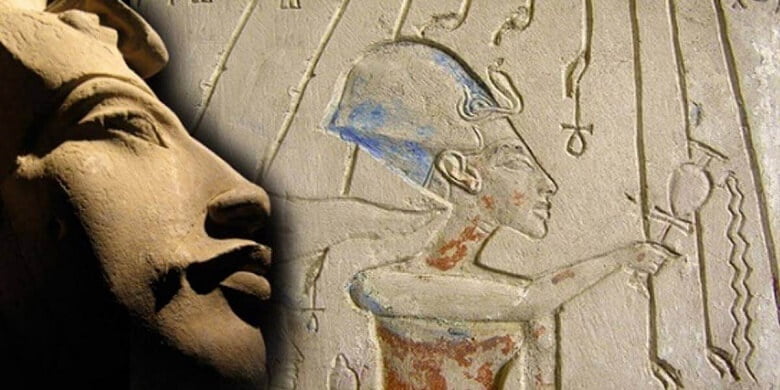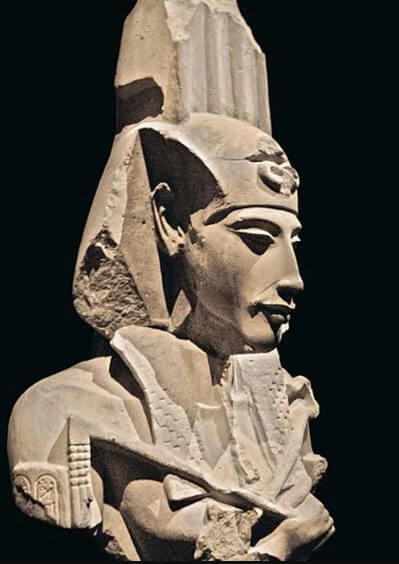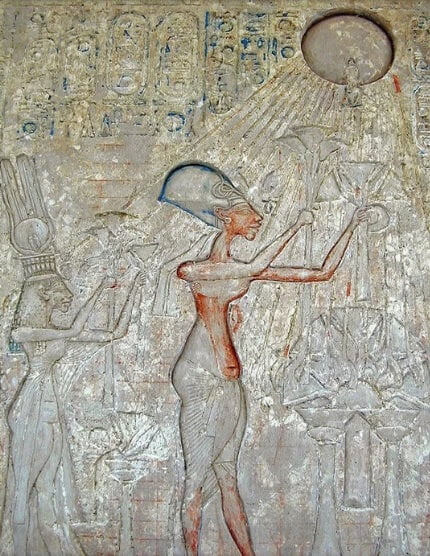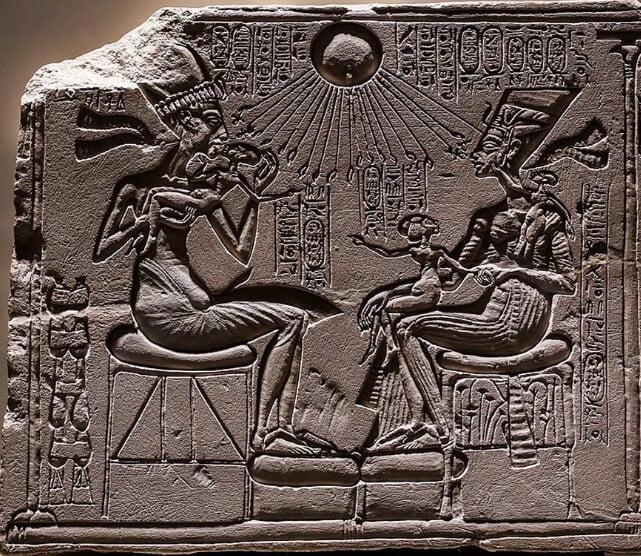
Egyptian Monotheism? Akhenaten, The Heretic King
Akhenaten was a pharaoh of Egypt who reigned over the country for about 17 years between roughly 1353 B.C. and 1335 B.C.
By Bipin Dimri | Historic Mysteries
The Egyptian pantheon is well established and much information about the gods survives. The evidence points to an enduring and well organized system of gods, with a broad pantheon and many temples to the gods and goddesses of Egypt.
However, one pharaoh tried to overthrow these gods and replace them with his own system. Akhenaten, the strange pharaoh of the 18th dynasty, banned the worship of these ancient deities and for a brief period, Egypt became monotheistic.
Akhenaten ruled between 1353 BC and 1336 BC, and during his reign much changed in his kingdom. He abandoned the traditional polytheism of Egypt and introduced “Atenism” that revolved around worshiping the sun disc named Aten.
During his reign, he reformed political and religious structure of Egypt drastically. He also developed new architectural and art styles and is known to have caused a lot of chaos in the Middle Bronze Age.
- Huge Discovery of 18,000 ‘Notepads’ Documents Daily Life In Ancient Egypt
- Mysterious Reincarnation of Omm Seti: British Woman Who Proved To Have Lived In Ancient Egypt
Born To Be King
Akhenaten was born as the second son of Amenhotep III and his wife Tiye, who named him as Amenhotep IV. He was born during the 7th or 8th year of the reign of his father.

While we know that Akhenaten had one elder brother and four or five sisters, very little information is available about Akhenaten as a prince. He was brought up in a palace, and most probably, retainers were assigned in order to educate him in the traditional ways of Egypt.
Later, Akhenaten married Nefertiti, who was known as his Great Royal Wife. The date and timing of marriage are not known. However, according to the inscriptions found on the building projects of the pharaoh, it can be said that they married shortly before Akhenaten took the throne.
Nefertiti is consistently depicted as a rare beauty, and seems to have been an object of veneration for the people of Egypt during the reign of Akhenaten. The couple are consistently depicted as near-equals, unusual in ancient Egypt, and based on inscriptions they seem to have had seven or eight children.
Early Years As Pharaoh
Amenhotep IV is known to have ascended to the throne at a very young age, taking the throne of Egypt in either 1353 BC or 1351 BC. The exact age of Amenhotep IV is not known when he took over the throne. However he was a very young pharaoh, somewhere between the ages of 10 years to 23 years.
He was crowned in Thebes, the central city of Egypt at that time with its ruling cult of Amun-Ra. During the initial years of his reign, he followed all the existing pharaonic traditions. He continued to worship the old gods, mainly the sun god named Re-Harakhte.
The temples of other gods were preserved, and the construction projects of his father were continued. Artistic depictions remained unchanged in the early years of reign, consistent with an artistic style which had endured for centuries. Tombs built in the initial years after Akhenaten ascended to the throne also had the traditional artistic style.
However, while he continued worshipping other gods, there were signs even at this early stage that he was moving in a new direction. His initial building program aimed at building new places in order to worship a god he had particularly chosen for his own: Aten.

Aten was the literal manifestation of the sun, depicted in reliefs as a blank disc with rays reaching out to touch the royal family, and only the royal family. He ordered the construction of shrines or temples for Aten in a number of cities in Egypt, such as Heliopolis, Kerma, Kawa, Bubastis, and more.
The Sed Festival
It was traditional of pharaohs to celebrate the sed festival at anniversaries of their ascension, to mark their kingly renewal. It was celebrated with drinking, eating, and dancing. Normally, the king used to organize their sed festivals after they had ruled for 30 years.
Amenhotep III had apparently celebrated three sed festivals, starting with his 30th year as a pharaoh. However, his son broke this tradition and decided to organize the sed festival only in the 2nd or 3rd year as a pharaoh.
In order to prepare for the sed festival, Amenhotep IV started building a number of temples. Many of them were built near the great temple complex of Karnak. So many temples were to be constructed that the architects of Amenhotep IV developed a new building style in order to speed up things with the use of smaller blocks.
Among all the temples built by Amenhotep IV, the largest one was Gemetpaaten at Karnak. It had a number of greater-than-life sized statues that were constructed using a new art style, changing centuries of tradition.
- Mummy With Gold Foil ‘Tongue’ Found In Sealed Egyptian Tomb
- Mummy of Famous Egyptian Pharaoh Digitally Unwrapped For First Time In 3,000 Years
Armana Art
During the reign of Amenhotep IV, this new art style that flourished was known as “Amarna art”. It was quite different from the traditional art form of ancient Egypt. Representations were known to be more naturalistic, realistic, and expressionistic.
Most strikingly, the statues or portrayals of Amenhotep IV greatly differed from the statues of other pharaohs. The portrayals of Amenhotep IV were very unflattering and unconventional, with broad hips, thick thighs, thin legs, a sagging stomach, thick lips, and exaggerated long face.

The unusual artistic representations of Amenhotep IV, as well as his family, made some people believe that they had physical deformities which were celebrated in his art. However, many researchers argue that the physical portrayal was actually a symbolic representation of the notions of Akhenaten about the infusion of light from Aten, the sun disc.
It may also represent the multiple life-giving functions of Aten. The skeleton found in the tomb of Akhenaten, although not certainly that of the pharaoh himself, also did not have any of the deformities as shown in the physical portrayals.
Atenism
Even though Amenhotep IV permitted the worship of other gods during the initial years of his reigns, there were a number of instances that indicated the growing importance of Aten. During the fifth year of the reign of Amenhotep IV, he made a decision to establish Aten as the only god of Egypt.
The pharaoh ordered a new capital to be built, away from the traditional power structures of Egypt, at Armana. The new capital would revolve around the sun worship of Aten, the cult of the royal family, and the establishment of a new power base at the expense of the old gods and their priests.
He even changed his name from Amenhotep, which meant “Amun is satisfied” to Akhenaten, meaning “in the service of Aten”. One of the reasons why he renounced the old Egyptian gods was that Amenhotep IV believed that Aten was not only the supreme god but the only god worthy of worship, and was also believed to be the creator of all life and the sole god. Aten was also seen as the life-sustaining and life-giving power.
Akhenaten abandoned all the temples that were dedicated to the traditional Egyptian gods and Amun, their chief, and built new ones for Aten. He even ordered the erasing of inscriptions that included the name of multiple gods. All the temples dedicated to Amun across Egypt were defaced.
A ban was also imposed on images of other gods except for the solar discs that represented the spirit of Aten. This caused much outrage amongst the people who were used to worship the existing pantheon, not least the priests of the old gods and their lucrative trade in funerary offerings.
Death of Akhenaten
After reigning for 17 years, Akhenaten died in 1336 or 1334 BC. The actual cause of his death is unknown.
Many of his radical changes to Egypt did not survive long after his death. His flirtation with monotheism was revoked by Tutankhaten, his successor and apparently his son, who changed his name to Tutankhamun in honour of the chief god of the old Egyptian pantheon, Amun.
Tragically, much of the strange distinctiveness of this period has not survived, and many mysteries remain about what happened at this time. Akhenaten was quickly seen as a heretic and much of his decorative artwork was desecrated or destroyed.
The new building style, with its small and standardized blocks, proved very useful to future builders who wanted an easy source of dressed masonry. As a result many of Akenaten’s temples were dismantled for their raw materials.
And so, much of the uniqueness of this strangest of all pharaohs was lost to history. But one cannot help but wonder what could have been. Had he been more successful in overthrowing the established orthodoxy of the ruling priests, had his successors followed his example, Egypt would have looked very different. And monotheism would have taken root centuries before the Hebrew Bible.
This article was originally published by Historic Mysteries.
